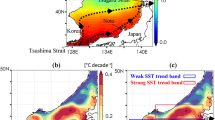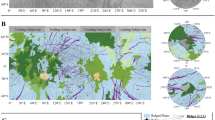Summary
The Mediterranean outflow is considered as two separate cores (upper and lower) which follow a well defined route between Gibraltar and Cabo São Vincente. Their physical and chemical properties are discussed in some detail and used as evidence for treating the upper core as a separate water mass. This core is also shown to suffer a 20% depletion in its concentration as it traverses the Gulf of Cadiz, whereas that of the lower core remains almost constant. In addition there was some indication of winter cooling and sinking of the shelf water which seems to be enhanced by the presence of the more prominent canyons in the area.
Zusammenfassung
Das Ausströmen des Mittelmeerwassers geschieht in zwei getrennten (oberen und unteren) Kernmassen, die sich entlang einer deutlich abgegrenzten Route zwischen Gibraltar und Cabo São Vicente ausbreiten. Ihre physikalischen und chemischen Eigenschaften werden ausführlich beschrieben und als Beweis dafür benutzt, daß man den oberen Kern als getrennte Wassermasse behandeln kann. Es wird auch gezeigt, daß dieser Kern beim Durchzug durch den Golf von Cadiz in seiner Konzentration um 20% abgeschwächt wird, wohingegen die untere Kernkonzentration fast konstant bleibt. Außerdem gibt es Anzeichen für ein Abkühlen und Absinken des Schelfwassers im Winter, welches durch das Vorhandensein von Cañons in diesem Gebeit verstärkt zu werden scheint.
Résumé
Le courant d'écoulement méditerranéen est considéré comme comportant deux couches distinctes (la supérieure et l'inférieure), qui suivent une route bien définie entre Gibraltar et le Cap Saint-Vincent. Leurs propriétés physiques et chimiques font l'objet d'une discussion détaillée et sont utilisées comme témoins permettant de traiter la couche supérieure comme une masse d'eau séparée. On montre également que cette couche subit une déperdition de concentration de 20% lors de la traversée du Golfe de Cadix, alors que celle de la couche inférieure reste presque constante. De plus, il a été constaté un certain refroidissement hivernal et un enfoncement de l'eau du plateau continental, qui semble renforcé par la présence des canyons les plus importants de la région.
Similar content being viewed by others
References
Boyce, F.M., 1975: Internal waves in the Straits of Gibraltar. Deep-Sea Res.22, 597–610.
Crepon, M., 1965: Influence de la pression atmosphérique sur le niveau moyen de la Méditerranée occidentale et sur le flux à travers le Détroit de Gibraltar. Cah. Océanogr.17, 15–32.
Defant, A., 1961: Physical oceanography. Vol. 1. Oxford.
Fuglister, F. C., 1960: Atlantic Ocean Atlas of temperature and salinity profiles and data from the International Geophysical Year of 1957/58. Woods Hole Oceanogr. Instn Atlas Series. 1.
Howe, M. R. and R. I. Tait, 1972: The role of temperature inversions in the mixing processes of the deep ocean. Deep-Sea Res.19, 781–791.
Howe, M. R., M. I. Abdullah and S. Deetae, 1974: An interpretation of the double T-S maxima in the Mediterranean outflow using chemical tracers. J. mar. Res.32, 377–386.
Cacombe, H., 1961: Contribution à l'étude du régime du Détroit de Gibraltar. I, Etude dynamique. Cah. Océanogr.13, 73–107
Madelain, F., 1970: Influence de la topographie du fond sur l'écoulement Mediterranéan entre le Détroit de Gibraltar et le Cap Saint-Vincent. Cah. Océanogr.22, 43–61.
Mamayev, O. I., 1975: Temperature-salinity analysis of world ocean waters. Elsevier Oceanography Series. 11.
Pingree, R. D., 1972: Mixing in the deep stratified ocean. Deep-Sea Res.19, 549–561.
Schott, G., 1928: Die Wasserbewegungen im Gebiete der Gibraltarstraße. J. Cons. perm. int. Explor. Mer.3, 139–175.
Stockman, W. B., 1946: A theory of T-S curves as a method for studying the mixing of water masses in the sea. J. mar. Res.6, 1–24.
Zenk, W., 1970: On the temperature and salinity structure of the Mediterranean water in the Northeast Atlantic. Deep-Sea Res.17, 627–631.
Author information
Authors and Affiliations
Rights and permissions
About this article
Cite this article
Ambar, I., Howe, M.R. & Abdullah, M.I. A physical and chemical description of the Mediterranean outflow in the Gulf of Cadiz. Deutsche Hydrographische Zeitschrift 29, 58–68 (1976). https://doi.org/10.1007/BF02227031
Received:
Published:
Issue Date:
DOI: https://doi.org/10.1007/BF02227031




